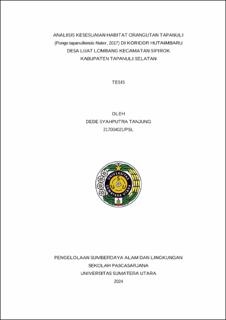| dc.description.abstract | The critically endangered Tapanuli orangutan (Pongo tapanuliensis) inhabits the Batang Toru Ecosystem and survives in two wild populations, but neither of these populations will survive in the long term. The combination of small population size and geographic isolation has led to inbreeding depression indicated in previous studies. One effort to prevent this problem is the establishment of corridors to connect fragmented habitats, especially western and eastern Batang Toru. The purpose of this study was to analyze the suitability of the Tapanuli orangutan habitat, the importance value index (INP), species diversity index (H’) and species wealth index (Dmg) of tree, as well as community perception and participation in the initiation of the Tapanuli orangutan corridor development in Hutaimbaru. The results of the AUC (Area Under Curve) test or random testing based on 25% of the sample obtained a model accuracy level of 0.993 while the AUC value of the overall prediction was 0.996, both of which were classified as Very Good with the highest environmental variable contributions being elevation, rainfall, and distance from forest cover. Based on the classification of habitat suitability classes, the Unsuitable Class was 60.23%, Suitable 28.77% and Very Suitable 11.00%. The highest INP tree growth rate in secondary forests was Hoteng (Lithocarpus hystrize) 28.68%, Mayang (Palaquium gutta) 22.55% and Hayu Horsik (Ilex pleiobrachiata) 17.81%, mixed gardens/agroforestri were Durian (Durio zibethinus) 21.44%, Mayang (Palaquium gutta) 18.82% and Medang (Persea declinata) 18.48%. The H’ results of the secondary forest tree growth rate were 3.19 (High) and mixed gardens/agroforestri 3.23 (High), while the secondary forest pole level was 2.71 (Medium) and mixed gardens/agroforestri 2.53 (Medium). Dmg tree growth rate in secondary forest at 5.63 (High) and mixed garden/agroforestri 5.96 (High), while the pole level in secondary forest 4.51 (High) and mixed garden/agroforestri value 3.79 (Medium). The results of the Hutaimbaru community questionnaire with a perception level of 61% (Medium) and a participation level of 67% (High). | en_US |


